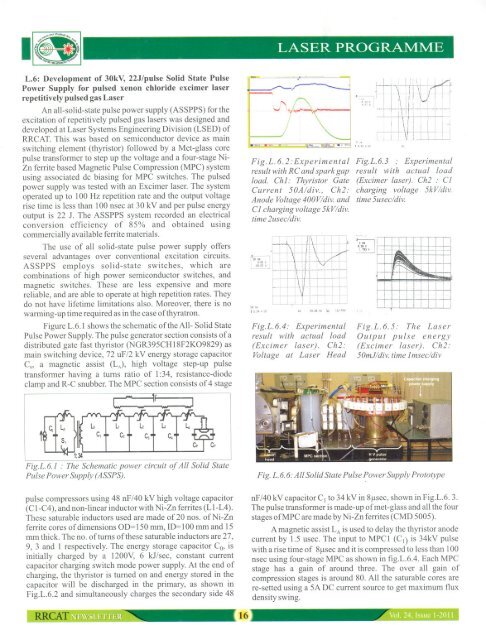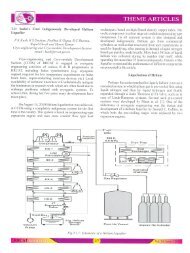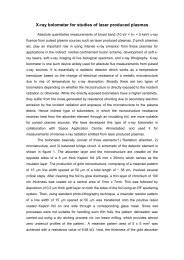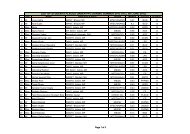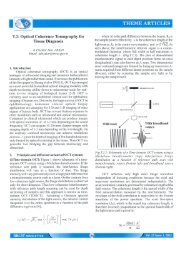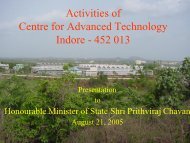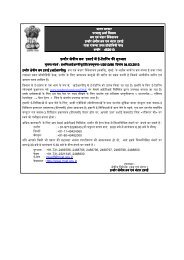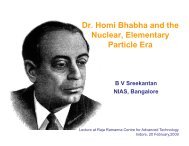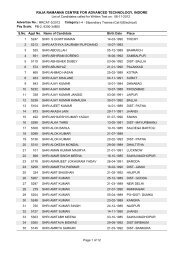Development of 30kV,22J /pulse Solid State Pulse Power Supply for ...
Development of 30kV,22J /pulse Solid State Pulse Power Supply for ...
Development of 30kV,22J /pulse Solid State Pulse Power Supply for ...
Create successful ePaper yourself
Turn your PDF publications into a flip-book with our unique Google optimized e-Paper software.
LASER PROGRAMME<br />
L.6: <strong>Development</strong> <strong>of</strong> <strong>30kV</strong>, <strong>22J</strong>/<strong>pulse</strong> <strong>Solid</strong> <strong>State</strong> <strong>Pulse</strong><br />
<strong>Power</strong> <strong>Supply</strong> <strong>for</strong> <strong>pulse</strong>d xenon chloride excimer laser<br />
repetitively <strong>pulse</strong>d gas Laser<br />
An all-so lid-state <strong>pulse</strong> power supply (ASSPPS) <strong>for</strong> the<br />
excitation <strong>of</strong> repetitively <strong>pulse</strong>d gas lasers was designed and<br />
developed at Laser Systems Engineering Division (LSED) <strong>of</strong><br />
RRCAT. This was based on semiconductor device as main<br />
switching element (thyristor) followed by a Met-glass core<br />
<strong>pulse</strong> trans<strong>for</strong>mer to step up the voltage and a four-stage Ni<br />
Zn ferrite based Magnetic <strong>Pulse</strong> Compression (MPC) system<br />
using associated dc biasing <strong>for</strong> MPC switches. The <strong>pulse</strong>d<br />
power supply was tested with an Excimer laser. The system<br />
operated up to 100 Hz repetition rate and the output voltage<br />
rise time is less than 100 nsec at 30 kV and per <strong>pulse</strong> energy<br />
output is 22 J. The ASSPPS system recorded an electrical<br />
conversion efficiency <strong>of</strong> 85% and obtained using<br />
commercially available ferrite materials.<br />
The use <strong>of</strong> all solid-state <strong>pulse</strong> power supply <strong>of</strong>fers<br />
several advantages over conventional excitation circuits.<br />
AS SPPS employs solid-state switches, which are<br />
combinations <strong>of</strong> high power semiconductor switches, and<br />
magnetic switches. These are less expensive and more<br />
reliable, and are able to operate at high repetition rates. They<br />
do not have lifetime limitations also. Moreover, there is no<br />
warming-up time required as in the case <strong>of</strong> thyratron.<br />
Figure L.6.1 shows the schematic <strong>of</strong> the All- <strong>Solid</strong> <strong>State</strong><br />
<strong>Pulse</strong> <strong>Power</strong> <strong>Supply</strong>. The <strong>pulse</strong> generator section consists <strong>of</strong> a<br />
distributed gate fast thyristor (NGR395CH18F2K09829) as<br />
main switching device, 72 uFI2 kV energy storage capacitor<br />
Co, a magnetic assist (LA)' high voltage step-up <strong>pulse</strong><br />
trans<strong>for</strong>mer having a turns ratio <strong>of</strong> I :34, resistance-diode<br />
clamp and R-C snubber. The MPC section consists <strong>of</strong> 4 stage<br />
Fig.L. 6.2: Experimental<br />
result with RC and spark gap<br />
load. ChI: Thyristor Gate<br />
Current 50A/div., Ch2:<br />
Anode Voltage 400V/div. and<br />
CI charging voltage 5kV/div.<br />
time 2usec/div.<br />
Fig. I. 6.4: Experimental<br />
result with actual load<br />
(Excimer laser). Ch2:<br />
Voltage at Laser Head<br />
Fig.I.6.3 : Experimental<br />
result with actual load<br />
(Excimer laser). Ch2 : CI<br />
charging voltage 5kV/div.<br />
time 5usec/div.<br />
Fig.L.6.5: The Laser<br />
Output <strong>pulse</strong> energy<br />
(Excimer laser). Ch2:<br />
50mJ/div. time Imsec/div<br />
Lo<br />
C,<br />
WLA S, 1:34<br />
Fig.1. 6. I : The Schematic power<br />
<strong>Pulse</strong> <strong>Power</strong> <strong>Supply</strong> (ASSPS).<br />
circuit <strong>of</strong> All <strong>Solid</strong> <strong>State</strong><br />
Fig. 1. 6. 6: All <strong>Solid</strong> <strong>State</strong> <strong>Pulse</strong> <strong>Power</strong> <strong>Supply</strong> Prototype<br />
<strong>pulse</strong> compressors using 48 nF/40 kV high voltage capacitor<br />
(CI-C4), and non-linear inductor with Ni-Zn ferrites (Ll-L4).<br />
These saturable inductors used are made <strong>of</strong>20 nos. <strong>of</strong>Ni-Zn<br />
ferrite cores <strong>of</strong> dimensions OD= 150 mm, ID= 100 mm and 15<br />
mm thick. The no. <strong>of</strong> turns <strong>of</strong>these saturable inductors are 27,<br />
9, 3 and 1 respectively. The energy storage capacitor Co, is<br />
initially charged by a 1200V, 6 kJ/sec, constant current<br />
capacitor charging switch mode power supply. At the end <strong>of</strong><br />
charging, the thyristor is turned on and energy stored in the<br />
capacitor will be discharged in the primary, as shown in<br />
Fig.L.6.2 and simultaneously charges the secondary side 48<br />
I RRCAT~~
LASER PROGRAMME<br />
The laser output <strong>pulse</strong> is shown in fig.L.6.5 is measured<br />
with pyro-electric detector. The measured output energy was<br />
150mJfpuise at 100 Hz. Fig.L.6.6 shows the first prototype <strong>of</strong><br />
this power supply.<br />
Reported by:<br />
D. V. Ghodke (dvghodke@rrcat.gov.in) K. Mural<br />
Krishnan N. Varshanay and N.S Benelji<br />
L.7: <strong>Development</strong> <strong>of</strong> 300J <strong>pulse</strong> energy long <strong>pulse</strong> Nd:<br />
YAG Laser<br />
The diode-pumped Nd:YAG and fiber lasers are not<br />
easy to operate in high energy, long <strong>pulse</strong> mode due to<br />
switching requirement <strong>of</strong> pump diodes. There<strong>for</strong>e, flash-lamp<br />
pumped <strong>pulse</strong>d Nd: YAG lasers with long <strong>pulse</strong> duration in the<br />
millisecond range are still important <strong>for</strong> various material<br />
processing applications. For deep penetration welding<br />
applications, it is desirable to have high energy and long<br />
duration <strong>pulse</strong>s. However, beam quality from high power<br />
Nd: YAG lasers is limited by strong thermal lensing and stress<br />
induced birefringence. Further, power scaling from single<br />
Nd: YAG rod is limited due to pump input and available rod<br />
length defined by thermal fracture limit <strong>of</strong> the rod, which is ~<br />
200 Wfcm. Thus, power scaling can be achieved by using<br />
multi-rod resonator or master oscillator power amplifier<br />
configuration (MOPA). Although, it is easy to design MOPA<br />
configuration, but due to variation in thermal focal length <strong>of</strong><br />
amplifier stage with variation in input pump power, it is<br />
difficult to achieve fiber optic beam delivery <strong>for</strong> the entire<br />
range <strong>of</strong> pump power. Thus, <strong>for</strong> fiber optic beam delivery, it is<br />
a better choice to use multi-rod resonator. It has already been<br />
reported that two-rod resonator with plane-parallel<br />
configuration has a wide stable range, when the two rods are<br />
symmetrically positioned inside the resonator. We have<br />
carried out design and development <strong>of</strong> a <strong>pulse</strong>d Nd: YAG laser<br />
providing 300 J <strong>of</strong> <strong>pulse</strong> energy with 40 ms <strong>pulse</strong>-duration<br />
using dual-rod resonator configuration.<br />
There are two identical pump chambers within the laser<br />
resonator. Each pump chamber is having a Nd:YAG rod, a<br />
lamp, and two halves <strong>of</strong> gold plated elliptical reflector. Each<br />
pump chamber contains 1.1 at.% Nd-doped rod <strong>of</strong> 10 mm<br />
diameter and 150 mm length. In each <strong>of</strong> the pump chambers, a<br />
10% samarium oxide doped glass plate is inserted between the<br />
lamp and rod to absorb the UV radiation from the lamp and<br />
convert the UV radiation into the useful visible light, thereby<br />
contributing to the laser output power. Both the pump<br />
chambers were cooled by closed-loop de-ionized water<br />
chillers. Two high voltage power supplies with master-slave<br />
configuration and rectangular current <strong>pulse</strong> pr<strong>of</strong>ile <strong>of</strong> variable<br />
duration from 2 ms to 40 ms along with capability <strong>of</strong> pumping<br />
both the cavities synchronously has been used. Figure L.7.1<br />
shows the schematic <strong>of</strong> symmetric dual cavity resonator and<br />
Fig. L.7.2 shows a view <strong>of</strong> the in-house developed. 300 J <strong>pulse</strong><br />
energy Nd:YAG laser with fiber optic beam delivery. Dual<br />
cavity resonator is constructed using a plane-plane<br />
20<br />
50%MIRR~<br />
Rod2 ~ d ~<br />
LENS<br />
Fig. L. 7.1: A schematic <strong>of</strong> the symmetric dual cavity<br />
resonator.<br />
Fig. L. 7.2 : A view <strong>of</strong> the in-house developed 300 J <strong>pulse</strong><br />
energy Nd: fA Glaser withfiber optic beam delivelY.<br />
--~'-:--~-"'-'T~-"'~'<br />
f(~ ,"I I I """<br />
I .. ~<br />
,I. ,<br />
--- I ;----- I I I....-<br />
~~_~ L U ...• • _L~ __ ~~._<br />
• (a) iiiliiii111 (b) iiiiiI<br />
FigL 7.3 : (a) Flashlamp pump-<strong>pulse</strong>, and (b) laser output<br />
<strong>pulse</strong> <strong>of</strong>300 J, 40 msfiber-coupled <strong>pulse</strong>d Nd: fA Glaser.<br />
symmetrical configuration with d: 2d: d configuration, where<br />
d is the distance between mirror and the principal plane <strong>of</strong>the<br />
rod.<br />
Figure L.7.3 shows the pump <strong>pulse</strong> and laser output<br />
<strong>pulse</strong> <strong>for</strong> 300 J <strong>pulse</strong>d Nd:YAG laser with fiber optic beam<br />
delivery. With dual rod resonator, a maximum average output<br />
power <strong>of</strong> 500 W was achieved with maximum <strong>pulse</strong> energy <strong>of</strong><br />
300 J at 40 ms <strong>pulse</strong>-duration. Maximum peak power <strong>of</strong> this<br />
laser is 10 kW. Laser <strong>pulse</strong> duration can be varied from 2-40<br />
ms with variation in <strong>pulse</strong> frequency from 1-100 Hz. Output<br />
<strong>pulse</strong> energy varies linearly with increase in input pump<br />
energy. Electrical to laser conversion efficiency is about 5%<br />
with beam quality <strong>of</strong> better than 20 mm.mrad <strong>for</strong> the whole<br />
range <strong>of</strong> operation from 0-10 kW. Laser beam has been<br />
delivered efficiently through an optical fiber <strong>of</strong> 400 /lm core<br />
diameter and 0,22 numerical aperture with 90% transmission<br />
at the fiber exit end. There are two fiber ports, which can be<br />
used on time sharing basis <strong>for</strong> different applications. Laser<br />
cutting up to a depth <strong>of</strong> ~ 20 mm and welding in SS up to a<br />
~ RRCAT~~'mm. _17 Vol. 24. Issue 1-2011


